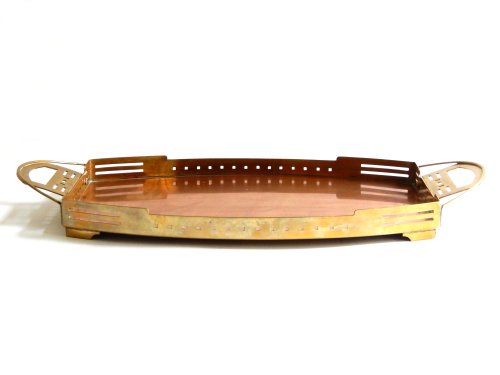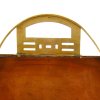Gustave Serrurier-Bovy (1858-1910) Tray
About this piece
A beautiful brass and copper tray with curved sides and an openwork geometric design. It is a well-known design by Gustave Serrurier-Bovy from 1905. It is not only beautifully crafted but also highly functional and sturdy. Every screw is visible, showcasing clear Art & Crafts elements. In addition to the geometric decoration, the style and class are timeless.
Truly a design piece.
Biography:
Gustave Serrurier-Bovy (Liège, Belgium, March 31, 1858 - May 4, 1910) was an influential Belgian architect and designer. Gustave Serrurier-Bovy studied architecture at the Académie Royale des Beaux-Arts in Liège. After completing his education, he embarked on his career as an architect and interior designer. He was greatly drawn to the Art & Crafts movement, and in 1884, he spent some time in the United Kingdom, working as a furniture designer. Upon his return, he opened his own furniture workshop and design studio, incorporating Art & Crafts elements into his designs.
His early work primarily consisted of traditional designs, but he quickly evolved into the Art Nouveau style. Recognized as a leading figure in the Art Nouveau movement, his work emphasized craftsmanship, the influence of the Art & Crafts movement, and the integration of art into everyday objects.
Serrurier-Bovy actively participated in various art groups such as La Libre Esthétique and was a pioneer in the development of Art Nouveau in Belgium. He, along with Henri van de Velde and Victor Horta, is considered one of the foremost architects in that field. His designs were influenced by both natural forms and geometric abstraction, characteristic of the Art Nouveau style.
He opened various branches in Brussels and Paris and exhibited at the World Exhibition in Brussels in 1897. In 1900, he designed and built the 'Restaurant au Pavillion bleu' pavilion at the World Exhibition in Paris.
Serrurier-Bovy was renowned for his furniture designs, combining traditional forms with innovative and organic elements. His furniture pieces were appreciated for their elegance and craftsmanship. He believed in the synthesis of art and craftsmanship, resulting in handmade pieces that were both functional and aesthetic.
In addition to his work as a furniture designer and architect, Serrurier-Bovy was also involved in decorative arts. He experimented with various materials, including copper and brass, and employed techniques such as cloisonné, where crushed copper wire was attached in motifs and then covered with coloured enamel.
In the early 1900s, Serrurier-Bovy visited Darmstadt, the center of Jugendstil. Afterward, he decided to simplify his work and opt for less expensive materials. Under the brand name Silex, he created a furniture line that could be self-assembled and, therefore, produced more affordably. In 1905, he also designed a series of furniture for workers. Today, this furniture by Serrurier-Bovy is highly sought after by collectors, known for its timeless, simple, and yet stylish design.
Serrurier-Bovy was a visionary who approached not only the artistic but also the social and economic aspects of design. He was one of the leading figures in the art world of his time, and his influence extended far beyond Belgium. Many of Serrurier-Bovy's furniture and decorative objects can be found in various international museums, such as the Musée d'Orsay, and Museum Boijmans Van Beuningen has his work in its collection.
Gustave Serrurier-Bovy passed away on May 4, 1910, in Brussels.
Literature:
- 'Wat is Art Nouveau & Art Deco waard,' Part I & II, edited by Rob Zeegers, Janny Stuurman-Aalbers, and Reinold Stuurman, Publisher Scriptum Art, Schiedam, NL, and Snoeck-Ducaju & Zoon, Ghent, Belgium, 2001. Part II, p. 168, 206, 223, 246 with illustration.
- Jacques Watelet; 'Gustave Serrurier-Bovy, architecte et décorateur, 1858-1910', Palais d'Académie, 1975.
Condition
Very good, the tray has a tiny dent in the bottom, it's not cleaned, because everybody has his own preferences about the colour of the copper.
Material:
Copper, brass
Measurements:
Length: 53 cm
(20,87")
Width: 26,5 cm
(10,43")
Height: 4 cm
(1,57")
Year:
1905
Origin:
Belgium
Artist / atelier:
Gustave Serrurier-Bovy,









